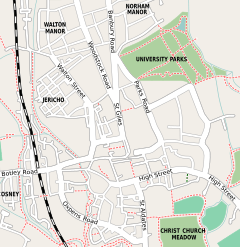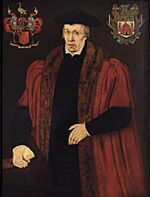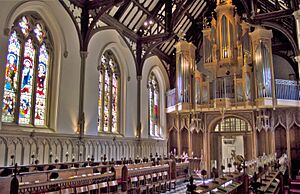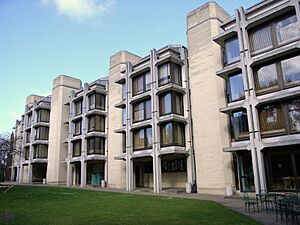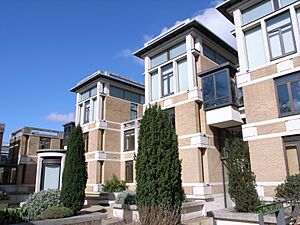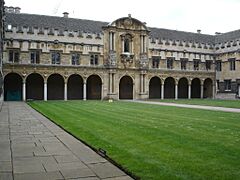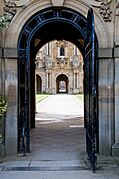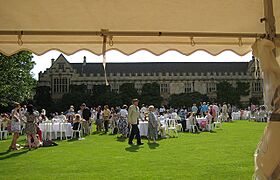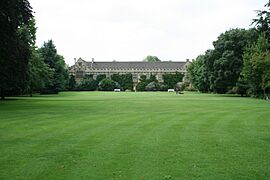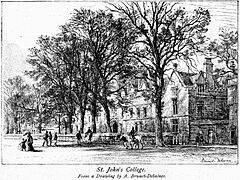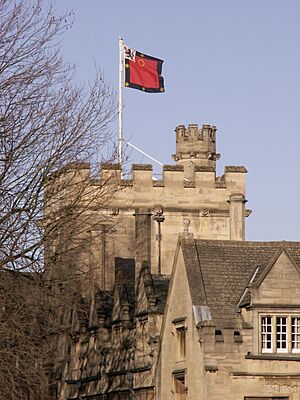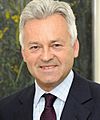St John's College, Oxford facts for kids
Quick facts for kids St John's College |
||||||||||||
|---|---|---|---|---|---|---|---|---|---|---|---|---|
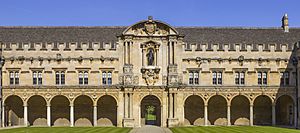
Canterbury Quad
|
||||||||||||
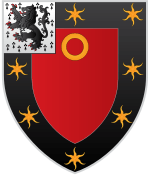
Blazon: of St John's College, Oxford (arms of Sir Thomas White): Gules, an annulet in chief or on a canton ermine a lion rampant sable a bordure of the fourth charged with eight estoiles of the second
|
||||||||||||
|
|
||||||||||||
| University | University of Oxford | |||||||||||
| Location | St Giles, Oxford OX1 3JP, UK | |||||||||||
| Coordinates | 51°45′22″N 1°15′31″W / 51.75612°N 1.258605°W | |||||||||||
| Full name | Saint John Baptist College | |||||||||||
| Latin name | Collegium Sancti Johannis Baptistae | |||||||||||
| Founder | Sir Thomas White | |||||||||||
| Established | 1555 | |||||||||||
| Named for | John the Baptist | |||||||||||
| Sister college | Sidney Sussex College, Cambridge | |||||||||||
| President | Sue Black | |||||||||||
| Undergraduates | 419 (2022) | |||||||||||
| Postgraduates | 244 (2022) | |||||||||||
| Boat club | SJCBC | |||||||||||
| Map | ||||||||||||
St John's College is one of the many colleges that make up the University of Oxford. It was started in 1555 for men only, but since 1979, both male and female students can study there. Sir Thomas White founded the college. He wanted it to train educated religious leaders.
St John's is the richest college in Oxford. In 2022, it had over £790 million. This wealth comes mostly from land it owns in Oxford that was developed in the 1800s.
The college is located on St Giles' street. It has about 390 undergraduate students and 250 postgraduate students. More than 100 teachers and many other staff work there. In 2018, St John's was ranked first in the Norrington Table. This table shows how well Oxford colleges' students do in their final exams. In 2021, it ranked second.
Contents
History of St John's College
On May 1, 1555, Sir Thomas White received permission from the King to start a school in Oxford. White had been the Lord Mayor of London. He wanted St John's to train religious leaders. One famous student was Edmund Campion.
White bought buildings on St Giles' street. These buildings used to belong to St Bernard's College, a monastery that closed in 1540. At first, St John's College was quite small and did not have much money. Over time, it grew and became more open to different students. Female students were first allowed to join in 1979. Elizabeth Fallaize became the first female teacher (fellow) in 1990.
In its early years, St John's mainly trained religious leaders. But it also became known for degrees in law, medicine, and PPE (Philosophy, Politics, and Economics).
College Funds and Property
St John's College received money and property when it was founded. In the late 1800s, the college became very rich. This happened because it owned a lot of land in Oxford that was used for new buildings.
Today, St John's has the largest amount of money and property among Oxford colleges. For example, it owns the Oxford Playhouse building and the training ground for the Millwall F.C. football team. In 2020, students protested for five days. They wanted the college to stop investing its money in fossil fuels.
Buildings of St John's College
The college is built on a large area of land, about 5.5 hectares. Most of its buildings are arranged around seven main courtyards, called quadrangles or "quads."
Front Quadrangle
The Front Quadrangle mostly uses buildings from the old St Bernard's College. Construction began in 1437. Sir Thomas White made many changes to create the college hall. The northern part of the eastern side is still used as the President's home today. The quad used to have gravel. For the college's 400th birthday, the round lawn and paths were added.
A clock from 1690 is in the tower above the Porters' Lodge. A statue of John the Baptist is also on the main tower.
Chapel
The chapel was built in 1530. It was re-dedicated to St John the Baptist in 1557. Inside, the chapel was changed a lot in 1840. These changes added the gothic-style seats, roof, and wall decorations. Thomas White, William Laud, and William Juxon are buried under the chapel. They were all presidents of the college. Laud and Juxon also became Archbishops of Canterbury. There is a hidden seat south of the main area. It allowed the president's wife to attend services without being seen.
Choir services have been held in the chapel since 1618. The famous song "This Is the Record of John" was written for the college. Today, the college choir sings services on Sundays and Wednesdays. Students who play the organ lead the choir. The chapel has always had an organ. The current organ was put in place in 2008.
Canterbury Quadrangle
This quad is special because it was the first example of Italian Renaissance architecture in Oxford. It was mostly built by Archbishop Laud and finished in 1636.
The college library is here. It has four connected parts. The college also keeps special collections here. These include the working library of writer Robert Graves. It also has the 'A. E. Housman Classics Library' with about 300 books that have notes written by Housman.
North Quadrangle
The North Quadrangle was not planned all at once. It grew over time as new buildings were added. The Cook's Building was built in 1612. The Senior Common Room, where teachers relax, was started in 1676. Its ceiling was finished in 1742.
Later, the St Giles' range of buildings was constructed between 1880 and 1909. The "Beehive" building, with its unusual hexagonal rooms, was finished in 1960. It is covered in Portland stone.
Dolphin Quadrangle
This quad was built between 1947 and 1948. It is in a style called neo-Georgian. There was a shortage of building materials after World War II. But the college used its own wood from Bagley Wood to build the new quad.
Sir Thomas White Quadrangle
Built from 1972 to 1975, this is an L-shaped building. It has student rooms on the upper floors. On the ground floor, there are common areas. These include the college bar, a TV room, a DVD room, and the JCR (Junior Common Room). Underground, there is a games room and an erg room for rowing. This building has won several awards for its design.
Garden Quadrangle
The Garden Quadrangle is a modern design from 1993. It includes the college's auditorium, student rooms, and kitchens. This building is very complex and not like a typical quad. It won five awards, and in 2003, a local newspaper poll voted it the best building built in Oxford in the past 75 years.
Kendrew Quadrangle
The Kendrew Quadrangle is the newest quad, finished in 2010. It is named after Sir John Kendrew, a former president of the college and a Nobel Prize winner. This quad is special because it tries to get energy from clean sources. Solar panels on the roof, pipes deep underground, and woodchips from the college's own wood help heat the building.
College Properties on Eastern Side of St Giles'
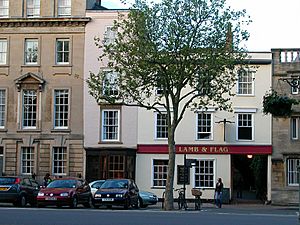
The college owns almost all the buildings on the eastern side of St Giles' street. Many of these are used for college purposes. Number 16 St Giles' House is a beautiful building from 1702. It is used for college dinners and events.
The Lamb & Flag pub is owned by the college. Until 2021, the college ran it. The money earned from the pub helped pay for scholarships for graduate students.
Western Side of St Giles'
The college also owns some buildings on the western side of St Giles'. This includes (until its sale in 2023) The Eagle and Child pub. Famous writers J. R. R. Tolkien and C. S. Lewis often met their friends there.
Gallery
Student Life at St John's
Facilities for Students
St John's College offers rooms for all undergraduate students for their entire course. First-year students usually live in the Thomas White Quad. Some students also live in houses owned by the college on Museum Road.
Middle Common Room
All graduate students are part of the Middle Common Room (MCR). The MCR helps represent graduate students. It also plans events and takes care of facilities for them. The MCR building was finished in 1998.
Student Groups and Clubs
The St John's College Boat Club (SJCBC) is the biggest sports club at the college. In 2013, the women's first rowing team became the "Head of the River." This was the first time any team from the club had achieved this in its 150-year history.
In 2006, St John's started SJCtv. It was the first Oxford college to have its own TV station. The college also has a drama group called St John's Mummers. Besides the chapel choir, the college hosts concerts by professional musicians. Two music groups open to all Oxford students also practice there: the Oxford Open Orchestra and Oxford University Symphonic Band.
People Connected to St John's
Famous Alumni and Teachers
Many important people have studied or taught at St John's. These include:
- William Laud and William Juxon, who were Archbishops of Canterbury in the 1600s.
- Lester B. Pearson, a former Prime Minister of Canada.
- Sadiq al-Mahdi, a former Prime Minister of Sudan.
- Poets like A. E. Housman, Philip Larkin, and Robert Graves.
- The writer Kingsley Amis.
- The biochemist Sir John Kendrew.
- Tony Blair, who was Prime Minister of the United Kingdom from 1997 to 2007.
- More recently, female politicians like Angela Eagle and Rushanara Ali.
- Professor Sarah-Jayne Blakemore, a psychology expert.
-
John Smith, a politician
-
William Laud, Archbishop of Canterbury
-
Tony Blair, former Prime Minister of the UK
-
Alan Duncan, a politician
-
Geoff Gallop, former Premier of Western Australia
-
Abhisit Vejjajiva, former Prime Minister of Thailand
-
Evan Davis, a journalist and TV presenter
-
Yannis Philippakis, a musician
-
Jakov Milatović, President of Montenegro
College Presidents
The current President of St John's College is Professor Dame Sue Black, Baroness Black of Strome. She is a Scottish forensic anthropologist. She is well-known for her work in identifying people in criminal cases.
|
See also
 In Spanish: Saint John's College (Oxford) para niños
In Spanish: Saint John's College (Oxford) para niños


